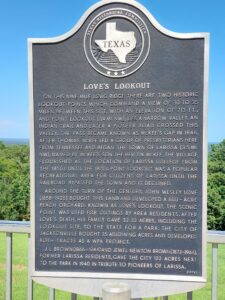Recently, several of my critique partners and I gathered in Tyler, TX, for a mini-writing retreat. On the way home, we stopped at a historic site/rest stop on the north side of Jacksonville. If you haven’t yet visited it, make plans to do so next time you’re in the area. In fact, take a picnic lunch and enjoy a little nature. You won’t be disappointed.
Love’s Lookout
I’ve driven by Love’s Lookout several times on my way to and from Tyler but never had a chance to pull in until now. It’s a charming rest stop with a scenic view. But the site is more than that. It’s a piece of Texas history and was recognized in 1978 as such with a historical marker (see below) by the Texas Historical Commission.
Love’s Lookout
Love’s Lookout Historical Marker
“On this nine mile long ridge there are two historic lookout points which command a view of 30 to 35 miles. Between this site, with an elevation of 713 ft., and Point Lookout (1/4 mi. NW), lies a narrow valley. An Indian trail and later a pioneer road crossed this valley. The pass became known as McKee’s Gap in 1846, after Thomas McKee led a group of Presbyterians here from Tennessee and began the town of Larissa (3.5 mi. NW). Named by McKee’s son the Rev. T.N. McKee, the village flourished as the location of Larissa College from the 1850s until the 1870s. Point Lookout was a popular recreational area for citizens of Larissa until the railroad bypassed the town and it declined.
Around the turn of the century, John Wesley Love (1858-1925) bought this land and developed a 600-acre peach orchard. Known as Love’s Lookout, the scenic point was used for outings by area residents. After Love’s death, his family gave 22.22 acres, including the lookout site, to the state for a park. The city of Jacksonville bought 25 adjoining acres and developed both tracts as a WPA Project.
J.L. Brown (1866-1944) and Jewel Newton Brown (1873-1966), former Larissa residents, gave the city 122 acres next to the park in 1940 in tribute to pioneers of Larissa.”
The Town
Wanting to brush up on my Texas history, I came home and researched the town of Larissa. As the marker said, Thomas McKee and a group of Tennessee Presbyterians arrived in 1846. Initially, they called their settlement the McKee Colony, but the following year, McKee’s son, T.N. McKee, a Presbyterian minister, laid out a townsite and called it Larissa. The town continued to grow, adding a Post Office in 1847, a Masonic lodge in 1849, and most of the businesses from the nearby failed town of Talladega in the early 1850s. During the mid-1850s, Larissa also had four stores, a salt works, a church, a three-story college building, and two large dormitories.
Did You Know…
- Reverend McKee created the new town of Larissa because the nearby community of Talladega had a saloon.
- The Reverend named this new town, Larissa, after an ancient city of learning in Greece.
- Because of its college, the town of Larissa was known as the “Athens of Texas.”
The College
Larissa College began as a one-room schoolhouse in 1848. Thomas McKee’s daughter, Sarah Rebecca Erwin, taught the first classes. The school, known as Larissa Academy at the time, built a three-story frame academic hall and two dormitories in 1850. Five years later, the Brazos Synod of the Cumberland Presbyterian Church assumed financial responsibility and changed its name to Larissa College. Unfortunately, their support lasted barely a decade.
Prior to the Civil War, the college had half a dozen faculty and 144 students. Two men and two women received diplomas in the spring of 1860. Then the war started, and the college temporarily closed. It reopened after the war, but a year later, in 1866, the church withdrew its support, and in 1870 the college was forced to close its doors for good.
Did You Know…
- Larissa College was one of the earliest institutions of higher learning in Texas. The Texas legislature approved the college’s charter on February 2, 1856.
- When the Presbyterians began financing Larissa College, they established both male and female departments, as well as a preparatory school.
- Larissa College offered “the strongest science work of the day in Texas.”
- In 1859, Larissa College purchased a large telescope—reported to be the South’s most powerful—for $700.
The End of a Dream
Larissa depended on the college, so its closing delivered a crippling blow to the town. It might have recovered if not for two other unexpected events. The first happened in 1872 when many of the remaining townsfolk died in a meningitis epidemic. The second, and most devastating, occurred in 1882 when the new railroad was built three miles to the east, luring most of the remaining residents away from Larissa and to the newly established community of Mount Selman.
Did You Know…
- The Larissa Post Office continued operating until 1905.
- By the Great Depression, only a church, school, store, and a few houses remained in Larissa. By the 1990s, that had shrunk to a lodge hall and a few scattered houses.
Other Photos from Love’s Lookout
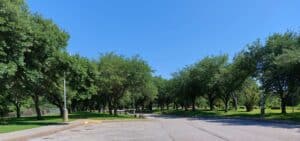
Road to welcome center.
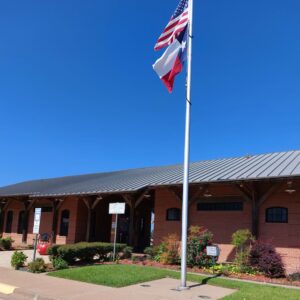
Welcome Center

Back of Welcome Center.
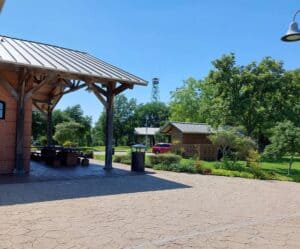
Back of the Welcome Center with Tower in distance.
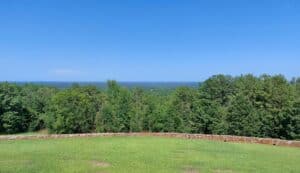
Scenic View from Love’s Lookout.


